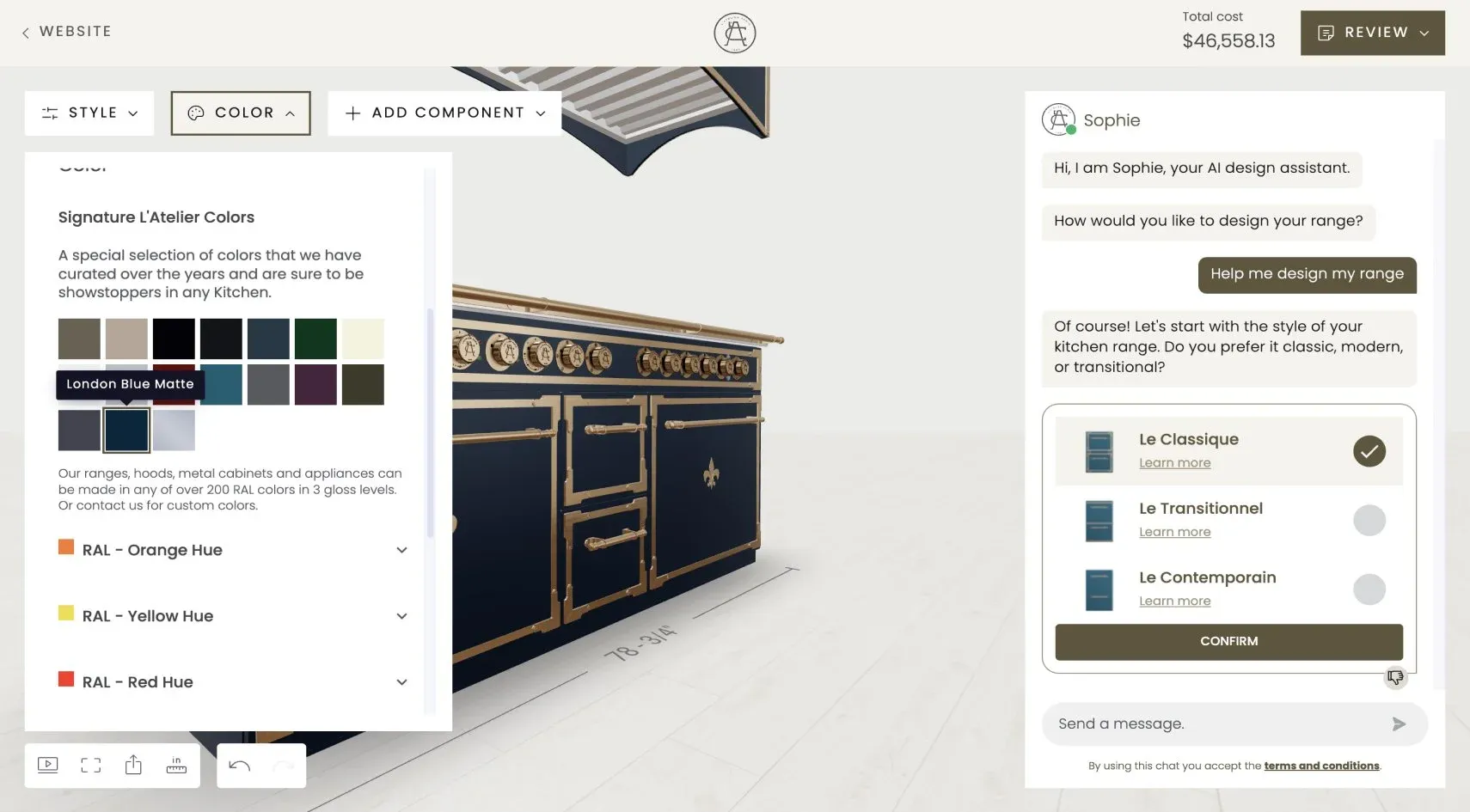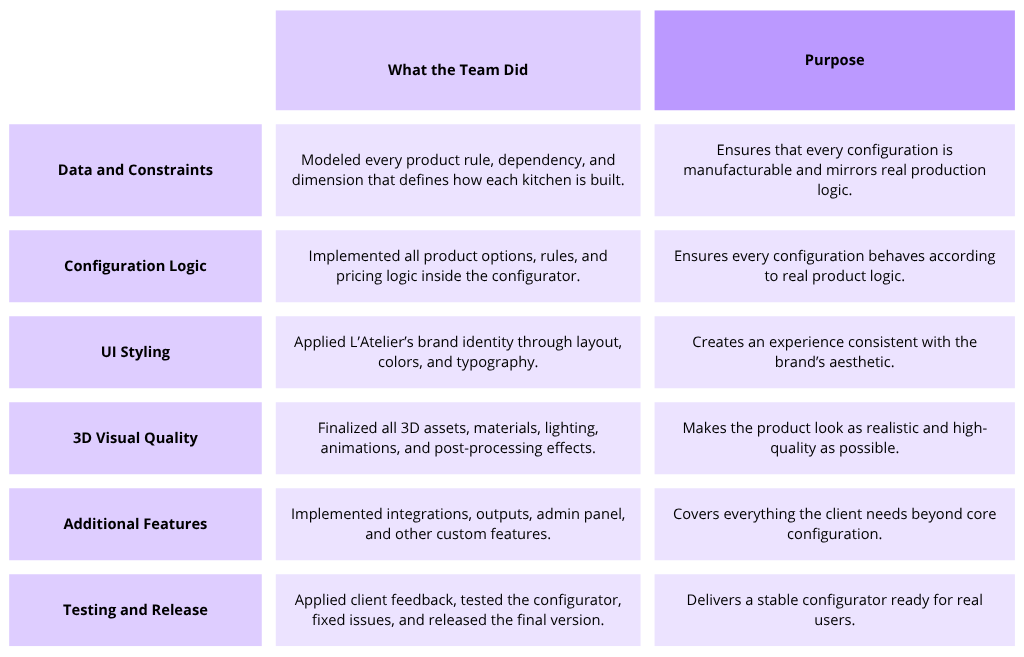Case Study: L’Atelier Paris Scales Made-to-Order Sales with 3D Configuration
Discover how L’Atelier Paris scaled its made-to-order kitchen sales with a 3D configurator that delivers real-time pricing and a conversational experience.

When everything you sell is made to order, scaling becomes a real challenge. L’Atelier Paris builds fully customizable kitchens that allow buyers to personalize every detail. Dimensions, materials, finishes, hardware, and even appliance layouts can all be adjusted. Translating that level of freedom into an online experience is a real challenge.
That’s where Salsita came in. The team built a 3D configurator that captures L’Atelier’s complexity while keeping the experience smooth for buyers. It combines high-fidelity 3D visuals, real-time pricing, advanced AI assistant, and manufacturing outputs in a single workflow.
In this case study, we’ll look at how the configurator was designed, the technical decisions behind it, and how it reshaped L’Atelier’s online sales process for made-to-order kitchens.
L’Atelier Paris: Kitchen Ranges With Thousands of Possibilities
L’Atelier Paris doesn’t build standard kitchens. They create fully custom environments where every cabinet, countertop, and appliance is made to order. Each piece is engineered to a fraction of an inch and finished to the client’s exact preferences. They can specify dimensions, materials, finishes, colors, hardware, and even the layout of built-in appliances.
This level of customization results in an almost illimited number of combinations. It’s what makes a L’Atelier kitchen unique, but it also makes the design process extremely complex. Translating that kind of precision into a digital experience required a system that could manage real data, real rules, and real performance. Not just pretty renders.

The Challenge: Bringing a High-Touch Buying Experience Online
L’Atelier Paris initially built its sales process around in-person showrooms. Customers could see materials, test appliances, and collaborate directly with designers on made-to-order layouts. But as the brand grew, this high-touch model didn’t scale. Moving online was the next step, and that’s where new challenges started.
The website showed only a fraction of what was possible. Buyers couldn’t experiment with real customization, and many left before contacting sales. Meanwhile, the sales team had to handle every configuration manually. Quotes required multiple revisions and constant follow-up. It was slow, error-prone, and impossible to scale efficiently.
The online experience also failed to match the product’s quality. It lacked interactivity, real-time rendering, and a sense of what “made-to-order” actually meant. To succeed online, L’Atelier needed more than a website. They needed a 3D configurator capable of handling complex product logic, live pricing, and manufacturing outputs. All inside a browser.
Defining the Technical Requirements
When Ricardo Moraes, CEO of L’Atelier Paris, first spoke with Salsita, his frustration was clear. The company’s previous configurator vendor had promised to handle the project’s full complexity but failed to deliver. The team wasted months of work, budget, and effort on a configurator that could not meet L’Atelier's precision needs.
L’Atelier decided to stop that project that didn't bring any ROI and turned to Salsita 3D Configurator instead. Rebuilding from that experience meant doing things differently. From the start, the goal was to build the configurator to support the whole variety of products on offer. It had to mirror how products were actually built, calculate pricing in real time, and deliver outputs ready for production.
The Salsita team sat down with Ricardo to fully understand how the company’s kitchens were built and sold. The goal was to translate that real-world process into a digital experience that combined precision with ease of use. From those discussions came a clear set of requirements:
- High-fidelity 3D models and visualization
- Parametric models for fully adjustable dimensions
- Real-time pricing built into the configuration flow
- Responsive, high-end UX optimized for both desktop and tablet
Implementation: Building the Configurator Architecture
Once the requirements were defined, Salsita’s development team started implementing the L’Atelier Paris Configurator in the Salsita Configurator Platform. The objective was to translate a high-end product into a high-end online experience that felt seamless, elegant, and true to the brand.
The implementation phase was structured around short development cycles, with progress shared every week or two and feedback applied immediately. This approach kept both teams aligned, ensured each update reflected L’Atelier’s vision, and grounded every decision in real business needs.

I’ve never experienced the delivery team living up to the sales team’s hype, but in Salsita’s case, they actually exceeded it. - Ricardo Moraes, L’Atelier Paris

Enhancing the Buyer Experience with Conversational AI
After the initial configurator rollout, L’Atelier Paris and Salsita identified a new opportunity: replicating the guided, in-store experience for online buyers. While the configurator already allowed for free exploration and advanced customization, many users still needed help navigating the complexity. That’s where Conversational AI came in.
We worked closely with L’Atelier’s sales team to understand how showroom consultations typically unfold. Based on that, we introduced Sophie, the first conversational configurator assistant, embedded directly into the configurator.
Sophie acts like a knowledgeable sales consultant. It can answer product questions, guide users through the configuration process, suggest options based on preferences, and even make direct changes to the configuration in real time. The goal is to provide a more intuitive and personalized experience for every user.
To support different user types, we designed three entry points for interacting with Sophie:
- Help Me Design: A step-by-step guided flow that walks the user through every configuration decision. Ideal for those who want support from beginning to end.
- Let Me Design on My Own: For users who prefer to explore independently. Sophie stays in the background, ready to assist when needed.
- I Will Describe My Ideal Cooking Range: Users can start by describing what they want in plain language. Sophie turns the description into a complete starting configuration that can be refined further.
Conversational AI gives users confidence and control while improving engagement and reducing drop-off. It is not just a chatbot, but an intelligent assistant that understands products, logic, and user intent.
Results: What L’Atelier Achieves with the Configurator
Since launching the configurator, L’Atelier runs operations more efficiently. The sales team works faster, customers get answers right away, and production starts from accurate data instead of revised sketches. What once took days now happens in a fraction of the time.
Increased Scaling Potential: The configurator allows sales teams to handle more deals without extra overhead.
Stronger Brand Consistency: The entire UX - design, layout, typography, and interactions - reflects L’Atelier’s premium aesthetic.
Higher Online Conversions: The interactive experience and AI design assistant reduce configurator abandonment and attract more qualified leads.
Faster Sales Cycles: Buyers configure their dream kitchen range and get pricing in real time, cutting back-and-forth with sales.
Lessons for Made-to-Order Product Manufacturers
For companies offering made-to-order products, the L’Atelier Paris project shows what’s possible when digital tools are built around real manufacturing logic. The biggest difference between success and frustration often lies in how you approach the project, and who you partner with.
Choose a partner who understands your product: Many can build a 3D experience, but few can connect it to the realities of production. Look for partners that speak the language of data models, rules, and constraints.
Define your real-world requirements first: Before any design work begins, document how your products are structured, priced, and produced. A configurator built on this foundation will support your workflow instead of fighting it.
Prioritize integration from the start: Your configurator should feed data into your existing systems: ERP, CRM, or production management. Without integration, you’ll create another silo that slows operations.
Plan for long-term collaboration: The best 3D configurators evolve over time. Choose a development partner who can iterate with you as your catalog, rules, and business goals grow.
Want a 3D Configurator Built Around Your Product and Stack?
L’Atelier worked with a team that understood how real products are built and how that translates into configuration logic, visuals, and data.
Salsita partners with manufacturers who want the same level of control and precision in their digital sales process. Our approach is collaborative and built around your actual production model rather than generic templates.
What you can expect:
- A deep understanding of your product structure and customization rules
- A single workflow connecting 3D visualization, live pricing, and production
- UX and design that reflect your brand and fit your buyers’ decision process
- A partnership focused on building configurators that evolve with your business
We work best with companies that build complex, configurable products and need digital solutions that go beyond simple visualization.

